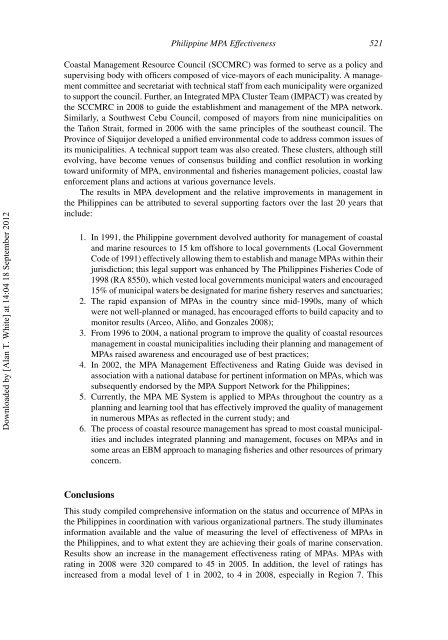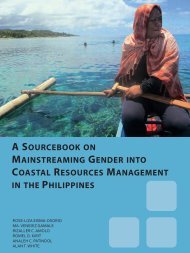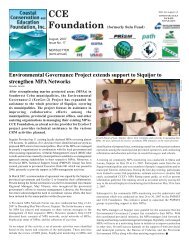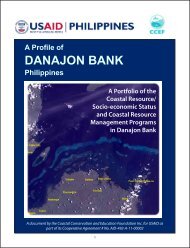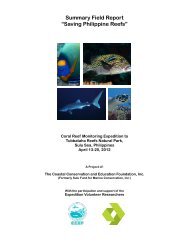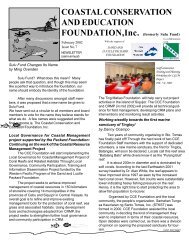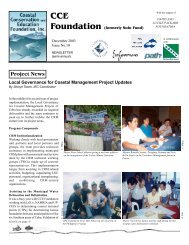Marine Protected Area Management Effectiveness: Progress and ...
Marine Protected Area Management Effectiveness: Progress and ...
Marine Protected Area Management Effectiveness: Progress and ...
You also want an ePaper? Increase the reach of your titles
YUMPU automatically turns print PDFs into web optimized ePapers that Google loves.
Downloaded by [Alan T. White] at 14:04 18 September 2012<br />
Philippine MPA <strong>Effectiveness</strong> 521<br />
Coastal <strong>Management</strong> Resource Council (SCCMRC) was formed to serve as a policy <strong>and</strong><br />
supervising body with officers composed of vice-mayors of each municipality. A management<br />
committee <strong>and</strong> secretariat with technical staff from each municipality were organized<br />
to support the council. Further, an Integrated MPA Cluster Team (IMPACT) was created by<br />
the SCCMRC in 2008 to guide the establishment <strong>and</strong> management of the MPA network.<br />
Similarly, a Southwest Cebu Council, composed of mayors from nine municipalities on<br />
the Tañon Strait, formed in 2006 with the same principles of the southeast council. The<br />
Province of Siquijor developed a unified environmental code to address common issues of<br />
its municipalities. A technical support team was also created. These clusters, although still<br />
evolving, have become venues of consensus building <strong>and</strong> conflict resolution in working<br />
toward uniformity of MPA, environmental <strong>and</strong> fisheries management policies, coastal law<br />
enforcement plans <strong>and</strong> actions at various governance levels.<br />
The results in MPA development <strong>and</strong> the relative improvements in management in<br />
the Philippines can be attributed to several supporting factors over the last 20 years that<br />
include:<br />
1. In 1991, the Philippine government devolved authority for management of coastal<br />
<strong>and</strong> marine resources to 15 km offshore to local governments (Local Government<br />
Code of 1991) effectively allowing them to establish <strong>and</strong> manage MPAs within their<br />
jurisdiction; this legal support was enhanced by The Philippines Fisheries Code of<br />
1998 (RA 8550), which vested local governments municipal waters <strong>and</strong> encouraged<br />
15% of municipal waters be designated for marine fishery reserves <strong>and</strong> sanctuaries;<br />
2. The rapid expansion of MPAs in the country since mid-1990s, many of which<br />
were not well-planned or managed, has encouraged efforts to build capacity <strong>and</strong> to<br />
monitor results (Arceo, Aliňo, <strong>and</strong> Gonzales 2008);<br />
3. From 1996 to 2004, a national program to improve the quality of coastal resources<br />
management in coastal municipalities including their planning <strong>and</strong> management of<br />
MPAs raised awareness <strong>and</strong> encouraged use of best practices;<br />
4. In 2002, the MPA <strong>Management</strong> <strong>Effectiveness</strong> <strong>and</strong> Rating Guide was devised in<br />
association with a national database for pertinent information on MPAs, which was<br />
subsequently endorsed by the MPA Support Network for the Philippines;<br />
5. Currently, the MPA ME System is applied to MPAs throughout the country as a<br />
planning <strong>and</strong> learning tool that has effectively improved the quality of management<br />
in numerous MPAs as reflected in the current study; <strong>and</strong><br />
6. The process of coastal resource management has spread to most coastal municipalities<br />
<strong>and</strong> includes integrated planning <strong>and</strong> management, focuses on MPAs <strong>and</strong> in<br />
some areas an EBM approach to managing fisheries <strong>and</strong> other resources of primary<br />
concern.<br />
Conclusions<br />
This study compiled comprehensive information on the status <strong>and</strong> occurrence of MPAs in<br />
the Philippines in coordination with various organizational partners. The study illuminates<br />
information available <strong>and</strong> the value of measuring the level of effectiveness of MPAs in<br />
the Philippines, <strong>and</strong> to what extent they are achieving their goals of marine conservation.<br />
Results show an increase in the management effectiveness rating of MPAs. MPAs with<br />
rating in 2008 were 320 compared to 45 in 2005. In addition, the level of ratings has<br />
increased from a modal level of 1 in 2002, to 4 in 2008, especially in Region 7. This


